Published on February 27, 2013
One hundred years ago this week, the Royal Aero Club’s newsletter, Flight, was arriving at manors and homes across Great Britain. Within its pages the major news was of the great Olympia Aero Show, at which the most prominent British aeroplane manufacturing and engine companies were on display. Among the first visitors was no less than His Royal Majesty, King George.
For history’s sake, we reporduce the Royal Aero Club’s report of the King’s experience at the show, but with a twist, as we include photos from the event so that you can experience the Olympia Aero Show as it was seen by the King himself! So set your post box TARDIS date to February 1913 and let’s go back in time a full century….
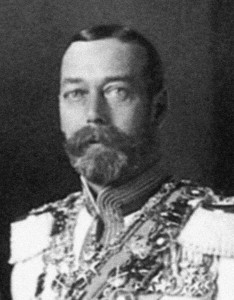
The Royal Aero Club Report
The February 22, 1913, newsletter carried details of the Olympia Aero Show and the King’s visit in typically British, breathless style, using the unique turn of phrase that helped define the era:
The Olympia Aero Show could not have been inaugurated in a more auspicious manner than that is first visitor should be no less a personage than His Majesty King George. His presence there on the opening day tells of the interest he holds for aviation, and by his action he sets his subjects a notable example, although we should have liked it to have gone a step further, by making a formal public opening of the Exhibition. His Majesty went to Olympia to acquaint himself with all the progress that aviation has made, to see for himself the important part that aircraft will play in wars of the future; his subjects should also go to Olympia while there is still time, and there learn the importance of this new science and industry, for it is to be feared that their knowledge of the subject is none too extensive.

The description continued by noting the King’s progress through the event hall, primarily making note of his increased attention to military uses of aeroplanes and dirigibles, a matter which was hotly debated at the time. In the very same newsletter, the Royal Aero Club published a map showing the distances German Zeppelins would have to travel to bomb various points within the United Kingdom, an overt attempt to use fear to motivate the British Government to greater action and funding for military aviation.
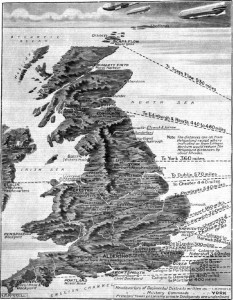
In hindsight, it was a prophetic map, given the strategic bombing raids by Zeppelins that would soon become a hallmark of the coming war in Europe, which, unbeknown to the readership, was just a year in the future.
His Majesty was attended by Lord Charles Fitzmaurice, Lord Loch, and Major Clive Wigram. Inside Olympia there were comparatively few people present for only a privileged few and those whose presence on the various stands was absolutely essential were in the building. In this way, the King was able to make his tour of the exhibits in perfect comfort.
His attention was first drawn towards H.M.A. “Delta,” the largest dirigible that the British Government has in its service, which is suspended from the roof of the exhibition. The King mounted the platform from which to view the car, and all its details were pointed out to him by Mr. Mervyn O’Gorman, the Superintendent of the Royal Aircraft Factory. He was shown how the balloon was made to rise and fall without loss of gas or ballast by changing the inclination of the propellers, how it was steered, and how the whole control of the vast machine was operated by the pilot from his comfortable seat in the nose of the body. The only detail that was not explained to him was the wireless telegraphy outfit by which, when the balloon is in flight, communication is kept with the headquarters. This apparatus had been dismantled from the car, for, naturally, it is not in the country’s interest to make public such important details.
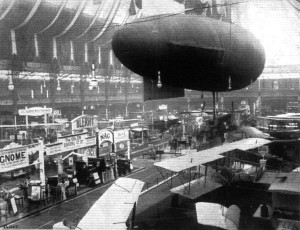
Continuing on, the King then looked over a series of aeroplanes, including the British manufactured types as well as some of the French designs being licensed within Britain.
Evidently vastly interested, the King passed on to the stand on which the two magnificent Bristol machines were shown. Here a detailed explanation of the machines was given by Sir George White and Mr. Thurston. Passing then to the stand of the Aircraft Manufacturing Co., he conversed for some time with Mr. Holt Thomas, the managing director of that firm constructing Farman aeroplanes in England. He was apparently much struck with the excellence of the finish of both machines, and had a remark to pass on the wind chart, exhibited on the stand, which recorded the strength of the wind that was blowing at the that Verrier started from Hendon to deliver a Maurice Farman biplane to Farnborough.
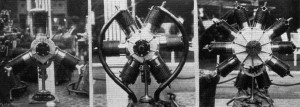
The engine displays were also of interest to the King, who clearly understood that the heart of an aeroplane is its engine; one might add that intuitively, he must have understood too that the aeroplane’s soul is the pilot. And from there, he viewed the Royal Aero Club’s own display of model aeroplanes.
Engines next received the King’s attention. He specially inspected the Green, the Renault, and the Gnome, and proceeded to the Handley Page stand, where it was explained to him by Mr. Page the system by which his machines are rendered to a great extent, automatically stable. On the Royal Aero Club stand His Majesty became vastly interested in the neatly constructed models that were there exposed for exhibition. Mr. Harold E. Perrin explained to him their details. He was particularly drawn towards the model hydro-aeroplanes, and expressed a desire that he would like to see them fly.
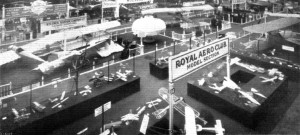
Returning to the subject of hydro-aeroplanes, the King was apparently quite taken with Mr. Grahame-White, one of Britain’s most famous aviators, as well as some of the other leading men of aviation at the time whose displays included actual aeroplanes on floats of various types.
Leaving that stand, he was shown more hydro-aeroplanes, but full-sized ones this time, on the stands of Messrs. Short Brothers, the British Deperdussin Aeroplane Co., the Grahame-White Aviation Co., and Messrs. J. Samuel White and Co. Mr. F. K. McClean, who was presented to the King at the Short stand, was congratulated by him most heartily on the magnificent performance he had accomplished in flying from Eastchurch up the river Thames into the very heart of London some months since on a Short hydro-biplane.
Passing along, the King chatted with Mr. Grahame-White for quite a long time, and with him mounted the platform from which to view the details of the interior of the cockpit of the new Grahame-White military biplane. He was evidently particularly interested in that massive biplane, for on the following day he commanded Lord Knollys to convey his congratulations by telegram to Mr. Grahame-White on having produced an aeroplane strictly for military purposes. Crossing on eof the main aisles, he examined the 50-h.p. Avro biplane, the various points of interest of which were made clear to him by Mr. A.V. Roe, its designer and constructor.
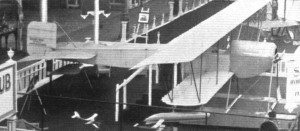
Thereafter, it was to the military aeroplane exhibits that the King wished to visit — again reflecting his increased interest in aviation for military purposes.
Thence the King proceeded to the War Office exhibits, the BE. 2 and the 120-h.p. Cody biplane. He chatted for some little while with the well-known constructor of that latter machine, for he had recollections of him, in the days when Mr. S. F. Cody was experimenting with man-lifting kites.
Before completing his visit the King visited the Vickers stand. Here again he showed the great interest that machines especially designed for military purposes possess for him, for of the two aeroplanes shown there, his attention was mainly directed towards the military biplane from the body of which protrudes a dangerous-looking Vickers automatic gun.
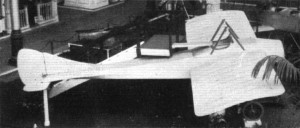
Ultimately, the King’s trip to the Olympia Aero Exhibition was welcomed as a sign that Britain was on the right path in developing its aviation industry, including its military arm. With every passing week, the Parliament had been addressing the needs of military aviation and new aeroplane designs were being developed rapidly. Nonetheless, all knew that Germany was far ahead, as was France at the time. What the future might portend, however, was still a mystery.
War was not far off and Britain would soon discover that its worst fears about the advanced state of aviation among its European rivals were not far off the mark. A dark shadow was soon to be cast across the Continent as the Iron Dice would roll.
